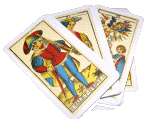
Bohemian Gothic Tarot
QUEEN OF WANDS
Lighter or more conventional meanings
An attractive woman * Someone passionate and sensual * An energetic and warmly affectionate person * A rather theatrical man or woman - this person likes to perform
Darker, shadow or more hidden meanings
Someone whose sensuality is disturbing * Overwhelming energy - a man or woman who tends to draw you into their own world * Witchcraft and dark magic * A vain, selfabsorbed woman (or feminine man) * A neurotic attention-seeker.Generally, the Queen of Wands is a curious card. It signifies a warm, energetic, fit and attractive person (usually but not necessarily a woman) who rather likes to be the centre of attention. Yet it is also often considered, together with The Moon, to point to witches and witchcraft - which are usually seen as secret, hidden activities. In the Bohemian Gothic we've emphasised the contradictions and ambiguities in a scene that is at once social - a ballroom - and isolated - the room is empty except for the dancer and a cat. The figure we see is beautifully clothed in a fine ballgown, yet the gown is red, possibly implying a scandalous "scarlet woman" rather than merely an attractive one. Furthermore we could well ask if this is a woman at all. It's unclear, and as we look, we may find ourselves equivocating between seeing a woman, or a rather ornately cross-dressed man.
Gender transgression and transformation are at the heart of the Gothic - from Le Farm's Carmilla, the vampire who kills boys but loves girls, to Arthur Machen's Helen Vaughan, who changes amorphously from woman to man and back again, right up to the present day writings of Anne Rice, with her bisexual, fantastical "blood hunters". It would be easy to say that this is merely another theme by which the Gothic sets out to shock us, part of the rich range of forbidden motifs with which the genre confronts us. But is it really so simple? Recent commentators (for example, see Kelly Hurley's essay in The Cambridge Companion to Gothic Fiction) argue that the fluidity of gender identity that so many Gothic stories exploit is part and parcel of the way in which the genre subverts and undermines notions of self and security. Just as human characters may metamorphose into beasts, and demons disguise themselves as human, so gender can shift and blur in a way that both disturbs and fascinates us.
When interpreting this card, it's useful to question the whole notion of attractiveness. What makes one person appealing and another not? How much is it a question of dress and presentation and how much about the inner person?
Some further ways to consider this card
There are two black cats, one real and one on the Queen's fan (you will need to look closely to see this one). What are the various ways in which you might interpret the symbolic presence of these cats? Consider how the figures painted on the ballroom wall might contribute to the potential meanings of this card.I layed with energies which I did not understand and you have seen the ending of it. Helen Vaughan did well to bind the cord about her neck and die, though the death was horrible. The blackened face, the hideous form upon the bed, changing and melting before your eyes form woman to man, from man to beast, and from beast to worse than beast...
- Arthur Machen, The Great God Pan.
We had birds, goldfish, a fine dog, rabbits, a small monkey, and a cat.
This latter was a remarkably large and beautiful animal, entirely black, and sagacious to an astonishing degree. In speaking of his intelligence, my wife, who at heart was not a little tinctured with superstition, made frequent allusion to the ancient popular notion which regarded all black cats as witches in disguise. Not that she was ever serious upon this point, and I mention the matter at all for no better reason than that it happens just now to be remembered.
- Edgar Allan Poe, "The Black Cat", Tales of Mystery and Imagination.
I was gazing into a large, empty room, with stone flags, and small, barred windows upon the farther wall. In the centre of this room, lying in the middle of a golden patch of sunlight, there was stretched a huge creature, as large as a tiger, but as black and sleek as ebony. It was simply a very enormous and very well-kept black cat, and it cuddled up and basked in that yellow pool of light exactly as a cat would do. It was so graceful, so sinewy, and so gently and smoothly diabolical, that I could not take my eyes from the opening.
- Arthur Conan Doyle, "The Brazilian Cat", Tales of Terror and Mystery.









